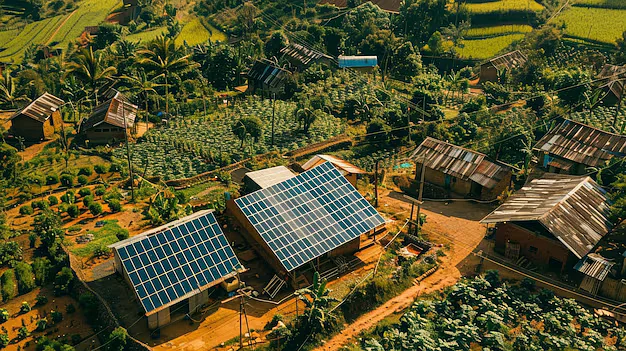With around 65 % of its people residing in villages and nearly half of them relying on agriculture for their livelihoods, India truly lives in its hinterland. The Heartful Village project jointly launched by the Hyderabad-based Heartfulness Institute with the US-based Plasma Water Solutions, is a thoughtful recognition of this reality. It focuses on creating model villages across the country oriented to sustainable livelihoods, eco-friendly agriculture and rural development.
Concept of ‘Heartful Village’
The concept combines sustainable farming practices such as organic cultivation and the use of biochar and biological fertilisers with innovative technology like plasma-ised water for enhancing crop health. The vision transcends agriculture and embraces initiatives for education, youth empowerment and community entrepreneurship, all aimed at lifting the quality of villagers’ life.
Advertisement
Though some of these methods are visible across rural India, there use is generally isolated, scattered and on a small scale. Heartfulness seeks to unify these fragmented forays into an integrated model for rural sustainability. Already state governments in Uttar Pradesh and Gujarat have partnered with Plasma Water, Samunati (an agri-enterprise), and Heartfulness, to pilot such efforts in their villages.
State Initiatives towards ‘Sustainable Villages’
The concept of sustainable, self-reliant villages gained traction about a year ago when Shivraj Singh Chauhan, the former Chief Minister of Madhya Pradesh, reached out to Heartfulness Institute to discuss how such models could be implemented on a larger scale. During his tenure, Chauhan had launched Ekatam Abhiyan, a yoga and meditation initiative aimed at improving the well-being of nearly 1.1 crore villagers. While running the programme, Heartfulness founder Kamlesh Patel (fondly known as Daaji), realised that yoga alone would not be enough to achieve the objectives of the well-being project. There was a pressing need to improve rural livelihoods by introducing sustainable economic practices.
Advertisement
Dr Shriram Raghavan, Director of Heartfulness Institute, says that the goal of a Heartful Village is to foster rural entrepreneurship, encouraging villages to innovate and create solutions for local challenges, which will ultimately lead to more sustainable and prosperous communities. In Madhya Pradesh this idea has been further institutionalised with the creation of the Madhya Pradesh Jan Abhiyan Parishad, an association focused on self-reliance through community participation. Chief Minister, Dr Mohan Yadav has endorsed the initiative promoting water conservation, renewable energy and natural farming. The Parishad also emphasises the importance of youth leadership and community-driven efforts to enhance income and well-being at the village level.
In addition, the state government has prioritised zero budget farming, which encourages farmers to rely on local resources instead of expensive external inputs, and animal husbandry reforms to improve livestock quality.
Meanwhile in Gujarat the government has taken steps to promote sustainable villages with its smart village incentive scheme. The initiative aims to integrate advanced technology and infrastructure to improve the quality of life in rural areas. In February 2024, Gujarat announced 16 smart villages, across the Rajkot Junagadh Jamnagar and Navsari districts.
Gujarat is home to India's first eco-village in Dhaj, near Surat. This village has grabbed attention for its use of solar panels, biogas plants, rainwater harvesting systems and water efficient farming techniques. The success of these villages lies in the collaboration between the Gujarat Ecology Commission and the states Forest and Environment Department, which help train villages in sustainable agriculture practices like drip irrigation and eco-friendly pesticides.
Advertisement
A Partnership Approach
While some States have made strides in promoting sustainability, the Heartful Village concept is a call for greater collaboration and integration as it brings together not only government agencies but also non-profits, agri-enterprises and technology companies like Plasma Waters.
Robert Hardt, CEO of Plasma Waters, explains how its technology helps plants fight diseases and pests promoting healthy and more resilient crops. The company’s plasma-ised water has been tested with farmers in Uttar Pradesh, Gujarat and Rajasthan, states facing unique agricultural challenges. In Rajasthan, for example, where water scarcity is a critical issue, plasma-treated water has led to both conservation and increased yields.
Advertisement
Other partners contributing to the initiative, include agricultural enterprises like Samunati organic Micro Greens and Urban Kisaan. Together they are creating sustainable agriculture systems through market linkages organic farming and innovative crop production techniques.
However, while partnerships and pilot projects are a step in the right direction, the success of the Heartful Village concept depends on border participation of local communities and government bodies. Public awareness and engagement will be key to encouraging people to adopt sustainable practices and contribute to the growth of such villages. As Dr Raghavan points out, for a Heartful village to thrive there needs to be a shift in mindset away from traditional, resource-intensive farming methods, towards a future where communities are self-sustaining and resilient to climate change.
Advertisement
If India is to achieve its goals of sustainable rural development, isolated efforts will need to combine into a nationwide movement at scale—one that unites farmers, policy-makers, entrepreneurs and local communities in a shared commitment to building Heartful villages across the country.
















 Just one email a week
Just one email a week